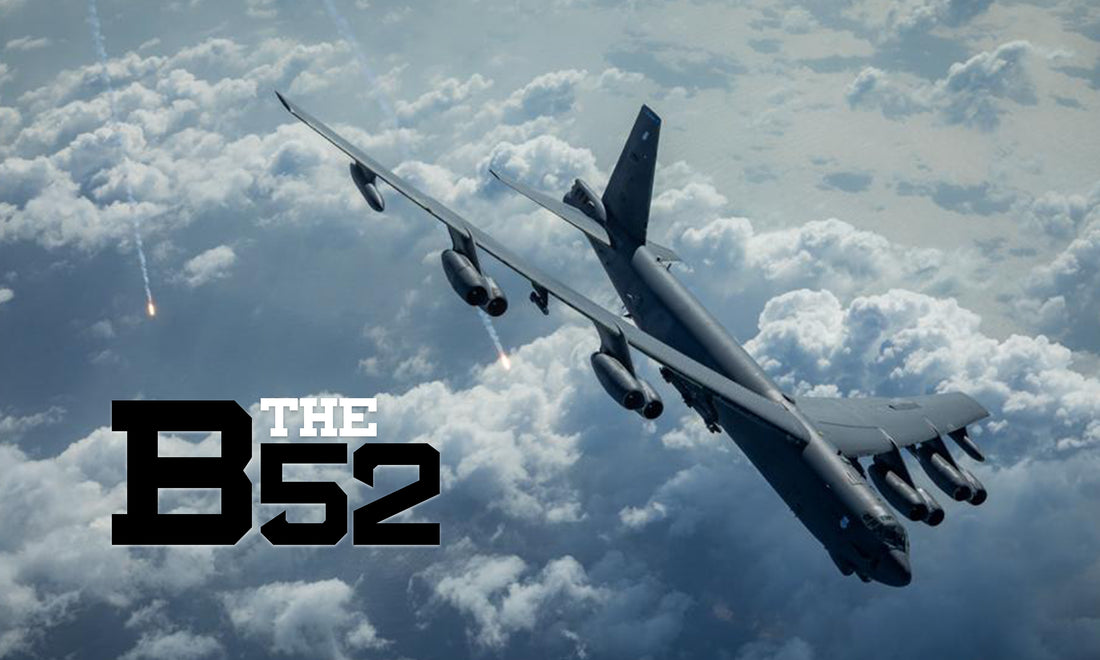Reporting for duty in 1955 and designed with intimidation in mind, the Boeing B-52 Stratofortress’ original mission was to carry the United States Air Force’s deterrence missions’ nuclear weapons during the Cold War. Now, an astounding near-70 years and multiple modifications later and with a guaranteed 20 additional years of service planned, the B-52 remains the largest, most often used strategic bomber in the USAF.
Due to its longevity as a staple in the Air Force, the B-52 arguably has the richest history of any aircraft ever invented.
Creating an Aircraft that has “All the Right Stuff”

In 1945, an entire decade before the B-52 would take its rightful place as the boss of the USAF’s bomber division, the military began looking for an aircraft that would be able to stand up to the possible threats of the impending Cold War.
The goal was for a manufacturer to invent a bomber capable of bearing a tremendous load while still allowing it to stay in flight for extended periods of time. The initial specifications issued by the USAF were for the craft to have four engines, be capable of achieving a combat radius of 5,000 miles, an altitude of 34,000 feet, and reach a minimum of 300 mph.
The challenge was issued, the gauntlet was thrown, and Boeing accepted, being given the $1.7 million contract for the initial prototype in 1946. But, those specifications, much like the fears facing our nation, continued to change based upon what was perceived to be the necessary level of defense against potential enemies.

Going through several incarnations before becoming what we would know to be the B-52, Boeing faced issues in development that included determining the proper wing position and engine types to support the behemoth and how to keep its sheer massive weight from devouring runways.
The B-52A, its initial model, took to the friendly skies in 1954, but Boeing still hadn’t gotten it quite right. The following year, the new and improved B-52B was declared the winner.
Nukes and Missiles and Bombs, Oh My!

In 1955, the B-52 was ready to show the rest of the world the American military was not to be messed with. It could transport and launch virtually any type of weapon the Air Force could throw at it. This bad boy could carry them all from nuclear weapons to mines, from various missiles to hydrogen bombs.
The specs on this modern marvel were astounding. They included:
- 8 Pratt & Whitney engines - each wing equipped with two pairs of four engines that would easily detach if on fire.
- A length of close to 160’.
- A height of over 40’, allowing for two levels of crew occupancy.
- An unreal weight of over 90 tons
- A monstrous wingspan of 185’.
- The ability to carry over 35 tons.
- The ability to reach over 650 mph.
- The ability to fly almost 9,000 miles without the need to refuel.
A crew of six was required to properly man this massive flying machine. Naming this aircraft the Stratofortress was dead on the money.
Cold War Intimidator

Living up to the USAF’s intent to deter attacks during the Cold War, the B-52 delivered. Though it was on Soviet border patrol throughout the entirety of the controversy, standing ready to counter-attack if the Soviets dropped their nukes, thankfully, the B-52 did not have to demonstrate its prowess.
Unfortunately for many of these amazing machines, the end of the Cold War signaled the end of their lives. After signing the Strategic Arms Reduction Treaty, the military destroyed many of its B-52 fleets as a show of goodwill.
Good Morning, Vietnam!

As an integral part of the USAF’s airstrikes during the Vietnam war, the B-52 fought bravely, though its fleet suffered several casualties.
On November 22, 1972, its first loss was felt as the aircraft was shot down while flying over Thailand.
In December of that same year, the B-52 fleet was given a chance to prove itself during Operation Linebacker II, and it did not disappoint. During the 12-day campaign, the aircraft was involved in over 700 attacks, dropping over 15 tons of bombs over Hanoi and other targeted areas.
15 B-52s were shot down during this mission, and over two dozen crewmen lost their lives.
In Vietnam, the B-52 made history as the largest aircraft to achieve air-to-air kills. Many skirmishes involved gunners taking down enemy fighters, further proving that, despite its size, the Stratosforce was ready to defend this country in whatever capacity necessary.

During this war, the fleet sustained a total loss of 31 bombers.
Dueling in Desert: Still Dominating Decades Down the Road
In early 1991, “old reliable” made history once again. Showing no signs of slowing down, the bomber finished the most extended combat mission up to that date. The assault on enemy forces featured an Air Force strike team from Lousiana, and it lasted over 35 hours. During the skirmish, the team of B-52s launched 35 Cruise missiles, 33 of which connected with their intended target. Over 14,000 miles were flown round-trip during the day and a half battle.
Following this attack, many Iraqui troops found themselves so disheartened by the destruction brought on by the Stratofortress that they opted to surrender.
In total, the B-52 fought in over 1,600 skirmishes and dropped 40% of all of the bombs launched by the coalition.
It Keeps Going and Going and Going

The B-52 was an integral part of the Afghanistan War triggered by the attacks on 9/11, and the invasion of Iraq in 2003. This legend of the skies also made appearances in:
- 2015 - Making its intimidating presence known in the South Seas of China due to jurisdictional issues.
- 2016 - Monitoring North Korea when the country claimed to test out a hydrogen bomb.
- 2016 & 2018 - Attacking pro-government Syrian forces.
Ch-Ch-Ch-Ch-Changes: The B-52A - H

Not including modification, eight different B-52 models were designed and put in service from 1954 - 1962, producing 742 aircraft in total. While some adjustments to these massive flying machines were minimal, others were drastic.
B-52A
This version was the prototype for what would eventually become part of the USAF fleet. There were three produced.
B-52B
This is the model that brought the B-52 into service. Fifty were made.
B-52C
Produced for one year, 1956, this model’s significant changes came and increased fuel capacity, giving the aircraft a more extended range. The body was painted white, holding 24,000 lbs of bombs. Thirty-five of this version took flight.
B-52D

Made from 1956-1957, this was the first high-volume production of the aircraft. In total, 170 of the Ds were made, and they were the primary bomber used in Vietnam thanks in part to their larger bomb bays. The paint scheme was also changed to a dark camo.
B-52E
Rolling out in 1957 and totaling 100 additional aircraft, the significant difference between the D and E came from the E’s ability to perform low-level operations. It also came with an improved bombing and navigation suite.
B-52F
Produced from 1958 - 59, the significant change between the E and F surrounded the engine. The 89 newly upgraded F series B-52s came with a lighter-weight Pratt & Whitney turbojet engine. Additionally, the engine pods on the wings were redesigned, now including a water injection system in each.
B-52G

The G version of the B-52 brought about the most significant changes in the fleet. Its most notable difference came with its new “wet wing” design, where the space within the wing itself was used for fuel storage. This increase in fuel capacity also improved its range.
The remodel also included a weight reduction in the big boy, taking away several thousand pounds and offering better crew accommodations. There were also improvements made in its bomb holding capacities.
From 1958 - 1959, 193 of the G series were produced. Sadly, this version took the brunt of the cuts from the Soviet arms agreement, causing many to be destroyed. The remaining Gs were placed in an aircraft museum in the early 90s
B-52H
Produced from 1961 - 1962, the H was the final incarnation of the B-52 bomber. It was similar to the G in most ways, boasting most of its changes in the areas of engine refinement and fuel efficiency. Its low-level capabilities were also improved.
There were 102 Hs made. This is the only version of the B-52 still used in the Air Force today.
Touch the Sky with Glory

The B-52, in all of its incarnations, will forever be a part of aircraft history. Due to its longevity, groundbreaking achievements, and unbelievable ability to break weaker spirits through sheer intimidation, the Boeing B-52 Stratofortress has left its mark on this world and has, in fact, touched the sky with glory.





